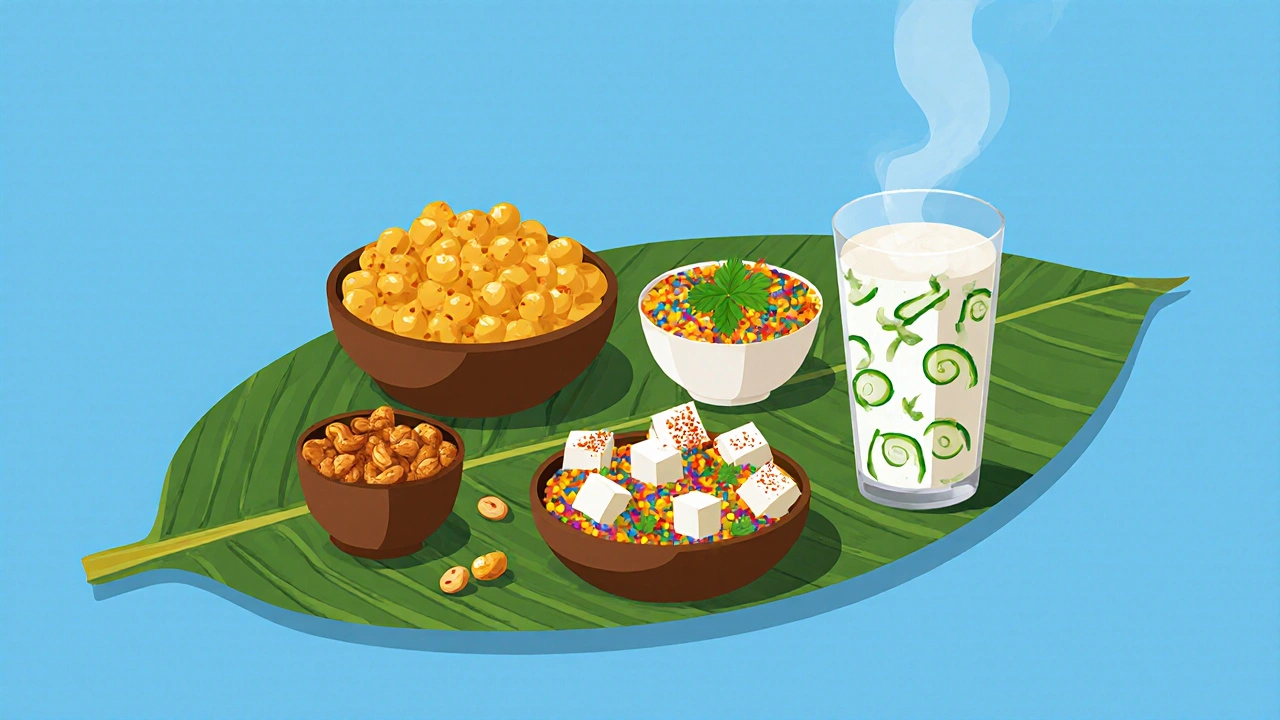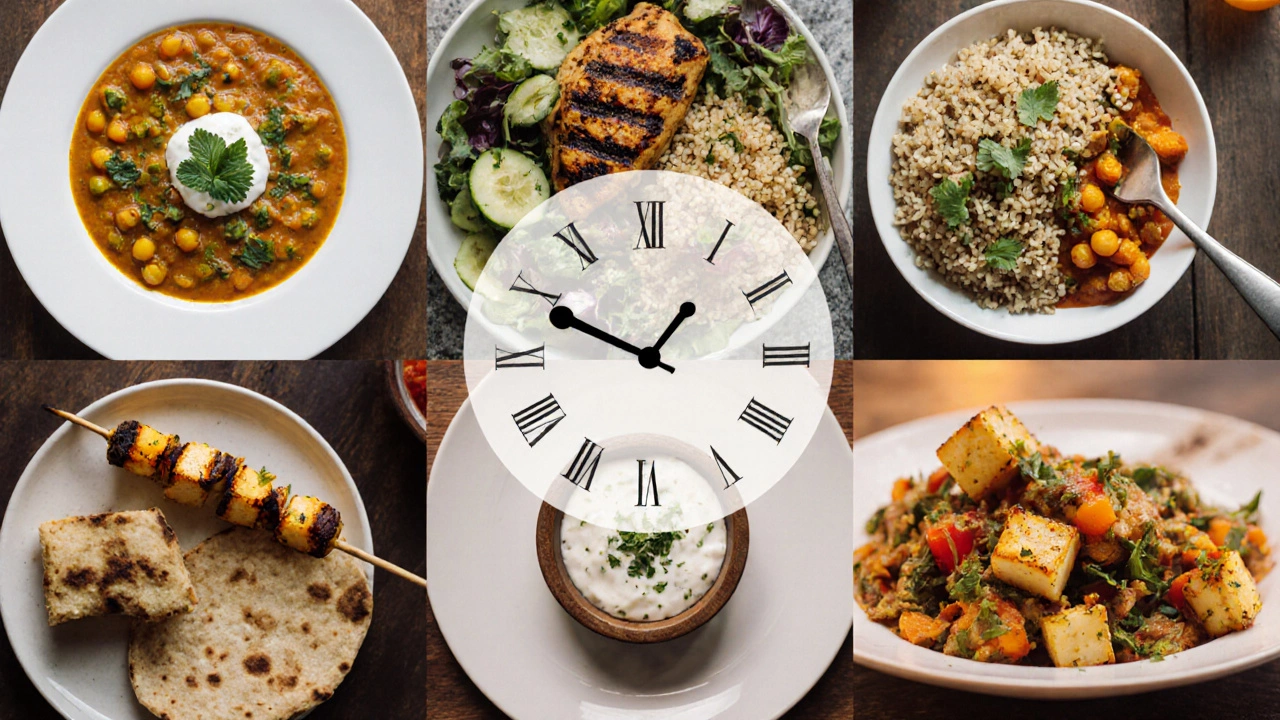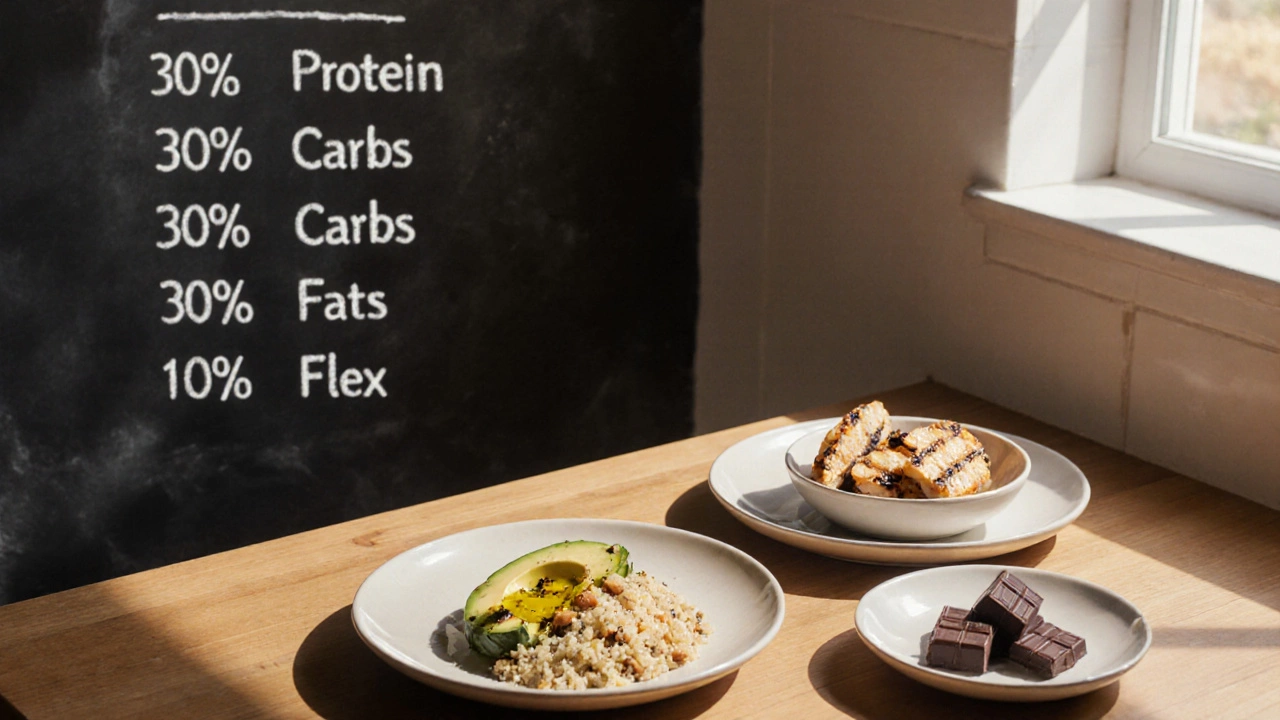30/30/30 Macro Calculator
Daily Calorie Target
Your 30/30/30 Targets
Remember: The remaining 10% is for flexible foods (like your favorite Indian snacks!)
If you’ve seen the 30/30/30 rule floating around diet forums, you’re probably wondering how a simple three‑number code can reshape your waistline. The answer lies in balancing calories, macros, and snack choices so you stay full, energized, and still shed pounds.
Key Takeaways
- The 30/30/30 rule splits daily calories into 30% protein, 30% carbs, and 30% healthy fats, leaving 10% for flexible foods.
- Apply the rule to Indian snacks by pairing low‑calorie, high‑protein bites with controlled portions of carbs and fats.
- Calculate your target calories first, then translate the percentages into gram goals.
- Track meals with a simple spreadsheet or app to stay on target.
- Common pitfalls include over‑estimating snack calories and ignoring fiber.
What Exactly Is the 30/30/30 Rule?
30/30/30 rule is a dietary guideline that tells you to allocate 30% of your total daily calories to protein, another 30% to carbohydrates, and the remaining 30% to healthy fats. The final 10% of calories are reserved for “flex foods” - things you love but consume in moderation.
By giving protein the biggest slice, you protect muscle mass while dieting. Carbs provide the energy needed for workouts and daily chores, and fats keep hormones balanced and keep you feeling satisfied between meals.
Why Macronutrients Matter
Macronutrients are the three building blocks of every food: protein, carbohydrates, and fats. Each supplies a different amount of energy per gram - protein and carbs deliver 4 kcal, while fats deliver 9 kcal.
When you allocate calories by percentage, you automatically get gram targets: multiply your daily calorie goal by the percentage, then divide by the appropriate kcal‑per‑gram value. For example, a 1,800 kcal plan yields 540 kcal from protein (135 g), 540 kcal from carbs (135 g), and 540 kcal from fats (60 g).
Step‑by‑Step: Calculating Your 30/30/30 Targets
- Determine your maintenance calories - the amount you need to stay weight‑stable. Online calculators use age, gender, weight, height, and activity level.
- Create a modest deficit (usually 10‑20% less than maintenance) to trigger weight loss.
- Apply the 30/30/30 split to your new calorie target.
- Convert each percentage into grams using the kcal‑per‑gram rule.
- Write the numbers down and use them as daily goals.
Example: a 28‑year‑old woman, 5’5”, 150 lb, lightly active. Maintenance ≈ 2,100 kcal. A 15% deficit gives 1,785 kcal. Split 30/30/30 → 535 kcal each for protein, carbs, fats → 134 g protein, 134 g carbs, 59 g fats.

Making Indian Snacks Fit the Rule
Indian cuisine is famous for its bold flavors, but many traditional snacks are high in carbs or unhealthy fats. The good news: you can still enjoy them by tweaking portions and pairing with protein‑rich sides.
Here are five snack ideas that naturally hit the macro sweet spot:
- Roasted chana - 1 cup (≈ 150 g) provides ~20 g protein, 45 g carbs, 2 g fat.
- Masala peanuts - ¼ cup (≈ 30 g) gives ~8 g protein, 6 g carbs, 14 g fat (use lightly roasted, unsalted).
- Low‑fat paneer cubes tossed with chaat masala - 100 g yields ~15 g protein, 2 g carbs, 5 g fat.
- Bhel Puri made with puffed rice, sev, and a generous handful of boiled chickpeas - ½ cup provides ~6 g protein, 30 g carbs, 4 g fat.
- Greek‑yogurt raita with cucumber and mint - ½ cup gives ~10 g protein, 5 g carbs, 2 g fat.
Notice how each snack contributes protein first, then carbs, and keeps fat moderate. Pair a higher‑fat snack (like peanuts) with a low‑fat option (like raita) to stay within the 30% fat ceiling.
Sample Day Using the 30/30/30 Rule and Indian Snacks
Below is a 1,800‑kcal plan that follows the rule, includes three snack moments, and showcases typical Indian flavors.
- Breakfast (450 kcal): Moong dal chilla (2 pieces) with mint‑coriander chutney - 30 g protein, 45 g carbs, 12 g fat.
- Mid‑morning snack (180 kcal): ¼ cup roasted chana - 10 g protein, 22 g carbs, 2 g fat.
- Lunch (540 kcal): Grilled tandoori chicken (120 g) + quinoa pulao (½ cup) + side salad - 35 g protein, 45 g carbs, 15 g fat.
- Afternoon snack (150 kcal): Greek‑yogurt raita (½ cup) with cucumber - 10 g protein, 5 g carbs, 2 g fat.
- Dinner (480 kcal): Paneer tikka (100 g) + mixed veg stir‑fry + small roti - 30 g protein, 38 g carbs, 20 g fat.
- Evening treat (0 kcal flex): A few pieces of dark chocolate (optional, fits 10% flex calories).
This menu hits roughly 140 g protein (30%), 170 g carbs (30%), 64 g fat (30%) - exactly the 30/30/30 split.
Snack Comparison Table
| Snack | Calories | Protein % | Carbs % | Fat % |
|---|---|---|---|---|
| Roasted chana (1 cup) | 210 | 38 | 53 | 9 |
| Masala peanuts (¼ cup) | 170 | 19 | 7 | 74 |
| Low‑fat paneer (100 g) | 120 | 50 | 5 | 45 |
| Bhel Puri (½ cup) | 140 | 12 | 68 | 20 |
| Greek‑yogurt raita (½ cup) | 80 | 62 | 12 | 26 |
Notice how roasted chana and low‑fat paneer naturally sit close to the 30% protein goal, while masala peanuts lean heavy on fat. Use the table to balance your snack stack: pair a high‑fat bite with a high‑protein, low‑fat one.

Common Pitfalls & How to Avoid Them
- Skipping the calorie count. Even a perfect macro split won’t work if you’re eating 3,000 kcal on a 1,800 kcal plan.
- Counting only “main meals”. Snacks can make up 15‑20% of your daily calories, so they must be logged.
- Ignoring fiber. Low‑fiber carbs cause cravings. Choose whole‑grain roti, lentil‑based snacks, or veg‑rich bhel.
- Over‑relying on deep‑fried foods. Frying adds hidden fat. Opt for air‑fried, baked, or roasted alternatives.
- Not adjusting for activity spikes. On heavy workout days, add a small protein shake to keep the 30% protein ratio.
Quick Checklist Before You Snack
- Calculate today’s calorie target.
- Convert 30/30/30 into gram goals.
- Pick a snack that provides at least 10 g protein per serving.
- Measure portion size - a kitchen scale helps.
- Log the snack immediately to avoid “forgotten calories”.
FAQs - All Your 30/30/30 Questions Answered
Is the 30/30/30 rule suitable for vegans?
Yes. Vegans can meet the 30% protein goal with soy, lentils, chickpeas, tofu, and tempeh. Pair those with whole‑grain carbs and healthy fats like avocado or nuts.
How does the rule differ from the classic 40/30/30 split?
The 40/30/30 model gives more calories to protein, which can be harder to sustain for many people. The 30/30/30 approach is a middle‑ground that still protects muscle while offering more flexibility in carbs.
Can I use the rule on a 2,200‑kcal diet?
Absolutely. 30% of 2,200 kcal is 660 kcal for each macro. That translates to 165 g protein, 165 g carbs, and 73 g fat. Adjust snack portions accordingly.
What’s a good low‑calorie Indian snack that fits the rule?
Roasted chana is a top pick - it’s high in protein, low in fat, and easy to portion. One cup delivers about 20 g protein while staying under 250 kcal.
Do I need to count every gram of macros?
A rough estimate works for most beginners. Aim for ±5 g per macro. As you get comfortable, tighten the tracking for better results.
